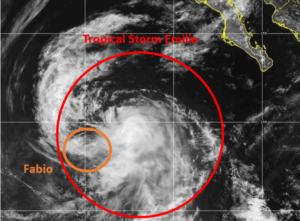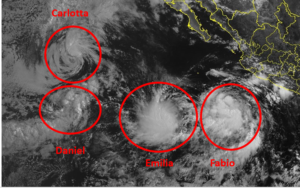The circulation around Tropical Storm Emilia absorbed the circulation of former Tropical Storm Fabio on Wednesday afternoon.
At 5:00 p.m. EDT on Wednesday the center of Tropical Storm Emilia was located at latitude 19.1°N and longitude 117.7°W which put the center about 565 miles (910 km) west-southwest of the southern tip of Baja California. Emilia was moving toward the northwest at 18 m.p.h. (30 km/h). The maximum sustained wind speed was 65 m.p.h. (105 km/h) and there were wind gusts to 80 m.p.h. (130 km/h). The minimum surface pressure was 990 mb.
At 5:00 p.m. EDT on Wednesday the center of former Tropical Storm Fabio was located at latitude 18.4°N and longitude 120.2°W which put the center about 735 miles (1180 km) west-southwest of the southern tip of Baja California. Fabio was moving toward the southwest at 16 m.p.h. (26 km/h). The maximum sustained wind speed was 40 m.p.h. (65 km/h) and there were wind gusts to 50 m.p.h. (80 km/h). The minimum surface pressure was 1004 mb.
The larger circulation around Tropical Storm Emilia absorbed the smaller circulation around Tropical Storm Fabio on Wednesday.
The absorption of Fabio’s circulation did disrupt the circulation around Tropical Storm Emilia, especially on the western side of its circulation. Bands in the northern and western parts of Tropical Storm Emilia consisted primarily of showers and lower clouds. Thunderstorms were still occurring in bands in the southern and eastern parts of Emilia’s circulation. The interactions of the two circulations also inhibited upper level divergence to the north and west of Tropical Storm Emilia.
Winds to tropical storm force extended out 115 miles (185 km) from the center of Tropical Storm Emilia.
Tropical Storm Emilia will move into an environment that will become unfavorable for intensification during the next 24 hours. Emilia will move move over water where the Sea Surface Temperatures are near 25°C. It will move under the axis of an upper level ridge over the Eastern North Pacific Ocean. The upper level winds are weak near the axis of the ridge and there will be little vertical wind shear. Tropical Storm Emilia will weaken when it moves over cooler water on Thursday.
Tropical Storm Emilia will move around the southern part of a subtropical high pressure system over the Eastern North Pacific Ocean. The high pressure system will steer Emilia toward the west-northwest during the next 24 hours. On its anticipated track, Tropical Storm Emilia will move farther away from Baja California.


